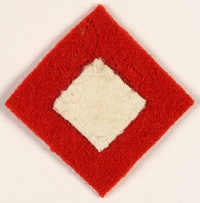The 'B' Assault Brigade RAC/RE. [1] was founded on 5 January 1945, in Italy. The Brigade Headquarters was formed from redesignating the 25th Army Tank Brigade's headquarters to the 25th Armoured Assault Brigade Royal Engineers. [2] Three months later, on 6 April, the formation was redesignated as the 25th Armoured Engineer Brigade Royal Engineers. The brigade served in Italy until the end of the war. [1]

The Durham and North Riding County Division was a coastal defence formation of the British Army during the Second World War. It existed only from 12 March 1941 until 1 December 1941, when it was redesignated Durham and North Riding Coastal Area and the subordinate brigade headquarters were disbanded. Most of the infantry battalions were then converted to other roles with the Royal Artillery or the Royal Armoured Corps. In its short existence the division had just one general officer commanding, Major-General P. J. Shears. It was under the command from X Corps from formation until 9 April and then under IX Corps.

The Lincolnshire County Division was a short-lived formation of the British Army, formed in the Second World War. The headquarters were formed on 24 February 1941, becoming operational on 27 March. It ceased to function on 25 November and was disbanded on 3 December. Its commanding officer was Major-General Arthur Kenneth Hay, and it was an infantry only formation consisting of three Independent Infantry Brigades (Home). Combat support, artillery, engineers etc., would be provided by other local formations. It was commanded by I Corps

The Yorkshire County Division was a formation of the British Army in the Second World War, its headquarters were formed on 24 February 1941, and became operation on 19 March. It was commanded by three officers, Major-General the Hon E. F. Lawson until 11 September, Brigadier G. H. Gotto until 23 September, Major-General E. C. Hayes until 20 November and then Gotto again. It was an infantry only formation consisting of three Independent Infantry Brigades (Home). Combat support, artillery, engineers etc., would be provided by other local formations. It was directly under Northern Command until 9 March and then came under I Corps. The Headquarters was redesignated the East Riding District on 1 December 1941.
The 43rd Royal Tank Regiment was an armoured regiment of the British Army's Royal Armoured Corps that tested and demonstrated specialised Armoured Fighting Vehicles during World War II.
The 51st Royal Tank Regiment was an armoured regiment of the British Territorial Army that fought in the Tunisian and Italian campaigns during World War II and continued to serve during the 1950s.
49th Royal Tank Regiment, later 49th Armoured Personnel Carrier Regiment and 49th Armoured Carrier Regiment, was a regiment of the British Army's Royal Armoured Corps during World War II that operated specialised armoured fighting vehicles in North West Europe.

The 6th Armoured Division was an armoured division of the British Army, created in September 1940 during the Second World War and re-formed in May 1951 in the UK.

The 25th Army Tank Brigade was an armoured brigade formation of the British Army that was active before and during the Second World War. It served with the British First Army and the British Eighth Army during the battles in North Africa and Italy.

The 8th Armoured Division was an armoured division of the British Army during the Second World War. It was deployed to Egypt in June 1942 but never operated as a complete formation and was disbanded in January the following year.

The 9th Armoured Division was an armoured division of the British Army, raised during the Second World War. It never saw active service during the war as a complete division.
The 24th Army Tank Brigade was an armoured brigade of the British Army. It was embodied in the United Kingdom at the outbreak of the Second World War. On 1 November 1940, it was redesignated as the 24th Armoured Brigade and reorganized. In July 1942, it transferred to Egypt and took part in the Western Desert Campaign, notably the Second Battle of El Alamein. The Headquarters was disbanded in the Middle East on 1 March 1943.

The 1st Cavalry Division was a regular Division of the British Army during the First World War where it fought on the Western Front. During the Second World War it was a first line formation, formed from Yeomanry Regiments. It fought in the Middle East before being converted to the 10th Armoured Division.

The 10th Armoured Division was an armoured formation of division-size of the British Army, raised during the Second World War and was active from 1941–1944 and after the war from 1956–1957. It was formed from the 1st Cavalry Division, a 1st Line Yeomanry unit of the Territorial Army (TA) which had previously been serving in Palestine. The division was converted from cavalry to armour and redesignated from 1 August 1941.

The 42nd Armoured Division was an armoured division of the British Army raised during the Second World War.
3rd Regiment Royal Horse Artillery is a regiment of the Royal Horse Artillery in the British Army. They are currently based at Albemarle Barracks, Northumberland, England.

The Guards Division was an infantry division of the British Army that was formed in the Great War in France in 1915 from battalions of the Guards regiments from the Regular Army. The division served on the Western Front for the duration of the First World War. The division's insignia was the "All Seeing Eye".
During the Second World War the British Army deployed armoured divisions and independent armoured and tank brigades.
2nd Regiment Royal Horse Artillery was a regiment of the Royal Horse Artillery that served in the Second World War. It saw action in France, Greece, North Africa and Italy. It was redesignated as 2nd Field Regiment, Royal Artillery in 1958.
The 36th Tank Brigade was a short-lived armoured brigade of the British Army raised during the Second World War. The brigade remained in the United Kingdom for its service and did not serve overseas, being disbanded in July 1943.